RETAIL FURNITURE HERITAGE
1800-2010
Retail Furniture Stories -Part 3
Many of the most enterprising home furnishings retailers have shared their stories of survival, growth and service with FURNITURE WORLD readers. This is the third installment in a series that commemorates the 140th anniversary year of FURNITURE WORLD Magazine.
These are your stories, the tales you told us, the dreams that became realities.
R.C. Willey
It was apparent back in 1932 that Rufus Call Willey was gifted with vision, resourcefulness and a positive attitude to hard work. But he might be just a tad startled to now hear himself described as, “The biggest furniture dealer west of the Mississippi with a dozen stores and a nearly 900,000 square foot distribution centre”. Especially when billionaire Warren Buffet announced his decision to acquire R.C.’s “little business”.
A full time employee of the local electric company in Syracuse, Utah, a small town northwest of Salt Lake City, Willey began selling Hotpoint appliances, washing machines, ranges and refrigerators, door-to-door as a sideline. Ingenious in his approach, since electricity was brand new to the area, he let his customers “try out” the appliances in their homes for a week, then financed their purchases in installments over a three year period, payable at harvest times.
During World War II, he maintained and nurtured relationships with his customers by restoring and selling ranges and refrigerators scavenged from salvage yards, and profited handsomely when exciting new appliances made their appearance at War’s end.
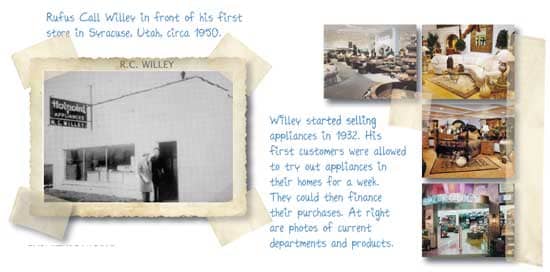
R.C. had routinely conducted business from the back of his red pickup truck but, in 1950, he knew the time had come to build his first small store right next door to his home. Two years later, William H. Child married R.C.’s daughter, Pat, and just two years after the wedding, William took over the business when his father-in-law became seriously ill. His brother, Sheldon, joined him in another two years. At that time sales were said to be about $200,000 annually, and William added furniture to their appliance inventory.
That same year, 1956, they remodelled the original 600 square foot store. It would eventually grow to a considerable 100,000 square feet. Willey’s second store came on the scene in 1969 in Murray, a suburb to the south of Salt Lake City, and in 1986, another store was opened at West Valley City. Business surged and both stores were expanded repeatedly.
It was in 1975 that R.C. Willey became one of the first retailers in the furniture industry to issue its own personal credit cards on a major scale, particularly bold in view of the fact that the trend was to move away from in-house financing altogether. But it ended up being a smart business move on a number of levels. Third-party lenders were eliminated, enabling stores to charge lower interest rates to customers while retaining profits. It also guaranteed more control over customers’ overall purchasing experience.
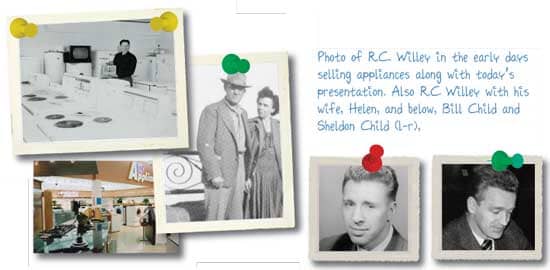
There was no doubt that the Childs had marketing flair. Free hot dogs were used to lure customers in the early ‘80s (so successfully they’re still a popular give-away), and media began to take notice of their activities. They reported that Willey’s success could be attributed to three factors, an eye for expansion, focus on the mid-range demographic and customer satisfaction.
And expansion continued in 1990 when a 73,000 square foot store was opened in Orem, just north of Provo in Utah County, at a cost of $5 million. Said trade publication HFD, R. C. Willey now “had six stores, one a clearance outlet, and employed 700 people with sales of $100 million”.
And it went on . . . and on! In 1991, a Central Distribution Centre was located in the middle of the Salt Lake Valley, and it included an adjacent 80,000 square foot store and 400,000 square foot warehouse. This project, according to the publication, cost the company $13.5 million. In the mid-90s, smaller furniture and carpet outlets were opened nearby and, in a suburb of Ogden, north of Salt Lake City, a 100,000 square foot store was established in 1996.
Now undeniably a “chain”, R. C. Willey’s expanded their inventory again to include fitness equipment, personal computers and snow blowers. To offer installation of car stereos, some stores were fitted with garages. They added futons in late 1994.
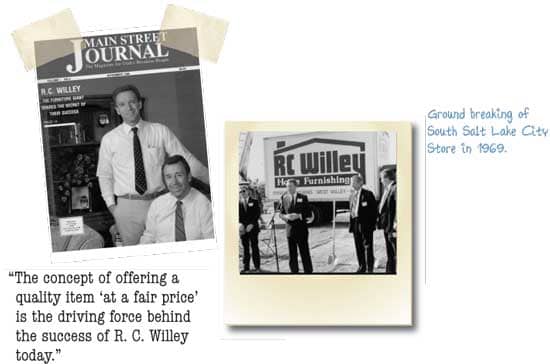
Word of their extraordinary success had filtered through to billionaire Warren Buffett. Bill Child, CEO of R. C. Willey, credited Nebraska Furniture Mart president, Irv Blumkin, with suggesting the deal to Buffett, owner of Nebraska Furniture for more than a decade. Buffet led the holding company Berkshire Hathaway Inc. It acquired R. C. Willey on May 24, 1995, at a reported price of $150 million in stock.
At the outset, Bill Child had wanted Buffett to know why he was interested in selling. “I want to be sure the company continues beyond my lifetime and, second, if anything were to happen to me or my wife, the business would have to be sold at a fire-sale price to pay estate tax.”
When asked by Buffett what Bill wanted for the company, he responded, “Just a fair price. We want whoever buys it to be just as happy ten years from now as they are the day they buy the company.”
Buffett left everyone in place to run the company. And the concept of offering a quality item “at a fair price” is the driving force behind the success of R. C. Willey today.
By that time, Willey’s seven furniture stores claimed annual sales of about $300 million, and the company had 1,300 employees. A study estimated Willey led the Utah home electronics market with a 28 per cent share and commanded more than half of the furniture market. Computer Retail Week wrote that Willey’s personal computer sales were about $20 million a year.
Of course, R. C. Willey continued to build, now with the backing of Berkshire Hathaway. Notably, their Intermountain Distribution Centre placed strategically right next to Salt Lake International Airport in 1997, was the largest of its kind in the United States at 860,000 square feet. The new Centre replaced three existing warehouses and cost $30 million.
The following year an outlet was opened in Provo and, that same year, the company ventured into the arts when the store in South Salt Lake City became the site of a mural, The Whaling Wall, by Wyland, the famous marine artist. Also, they leapt into technology with the testing of an interactive kiosk system inside most of the stores.


It was time to spread corporate wings in 1999 when a store was opened in Meridian, Idaho. Predictably, it instantly claimed the leading spot in that market. Just two years later, they broke ground for a 162,500 square foot store in Henderson, Nevada.
By the millennium, revenues were approximately $400 million and there were 2,000 employees. Furniture accounted for 60 per cent of sales, bedding sales $25 million, and Willey’s credit operations held more than $185 million in loans which made it one of Utah’s largest finance companies.
As was their custom, Willey’s spent heavily on advertising and promotions. Hot dogs were still high on the list, 600,000 giveaways each year! And for special events, Willey’s teamed with pizza restaurants like Domino’s in their giveaways.
In 2001, there was a top management shuffle when chief financial officer Scott L. Hymas succeeded Bill Child as CEO with Child remaining as chairman. And his nephew, Jeffrey S. Child, became Willey’s president.
May 2003 saw the opening of a second Las Vegas area store. Store sales were averaging between $35 million and $90 million. Forty-one per cent of sales originated outside Utah by 2004, according to Warren Buffet’s yearly letter to Berkshire Hathaway shareholders.
In 2004, sales were $500 million, making it one of the top 20 home furnishings retailers in the United States.
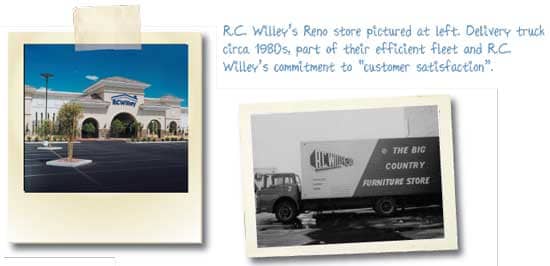
Since R. C. Willey was founded in 1932 during the Depression, the current economic situation, while challenging, certainly isn’t daunting to Jeff Child, now at the helm. In 2004 honoured by his peers as Retailer of the Year in the over $10 million category for his service to the industry, service to his community and creative leadership of his own company, Jeff is also President of the National Home Furnishings Association.
Critelli’s Furniture
North of the world’s friendliest border, it was more than a century ago when a young Italian immigrant, Joseph Critelli, saw opportunity beckon in the thriving Niagara Region of Southern Ontario. We remember and recognize him as one of the innovators of his day, and the patriarch of a prominent and respected family.
Now, his great-grandson and namesake, Joe, is president of Critelli’s Furniture and Transitions, both well established medium high to upper end home furnishings stores in bustling St. Catharines.

The first Joseph was a contractor and he had been hired to help in the creation of the vast hydroelectric projects at Niagara Falls on both sides of the border between Canada and the United States. He brought his own workers with him from Italy, and they did well. Joseph raised a large and happy family, decided to put down roots and call Canada home.
It was customary in those days for successful men to set their children up in business. Eldest son, Thomas H. Critelli, with Joseph’s assistance and encouragement, opened the family’s first retail store in 1914 selling groceries and hardware in the nearby town of Thorold. His natural creativity and design instincts lured him to fine furniture and, by 1936, four years after Rufus Call Willey kicked off his dream south of the border, Thomas’s store was thriving. He opened a second store with his younger brother, Frank, in Niagara Falls. Although the Depression was still a factor in other regions, there was an exciting construction boom along the busy Welland Canal that complemented the optimism of Canadian expansion.
In keeping with the patriarch’s vision, Thomas founded a third store in downtown St. Catharines and the business grew rapidly. Thomas sold the Thorold store to his employees in order to concentrate on the St. Catharines’ enterprise and his son, Thomas Joseph, Joe’s father, joined him in 1946.
By 1961 there were four showrooms and an on-site warehouse. Expansion was vital and in 1963, they built their King Street store, closed the Niagara Falls location and, said Joe, “everything came together under one roof.
“I still remember the early days, truly a family business. My father worked in the store, raised a family of six kids and I have wonderful memories of those times. My grandfather, too, enjoyed the business tremendously and worked until he was 89!”
Joe officially joined the company in 1980, and his sister, Misette, nine years later, the third generation of Critellis. In 1989, Joe took over ownership.
Thirteen years later, part of his search for new ways to meet customer needs, Joe opened a second St. Catharines store, “Transitions”, just around the corner from their traditional home base. Aptly named, Transitions “tells a new story in a new way” with contemporary flair, and it was sister Misette’s territory from the outset.
Joe is still “deeply intrigued” by “changes in our customers’ shopping habits, and we’re approaching them in very proactive manners in each of our stores and on the Internet. You can’t begin to count the ways now of shopping for furniture. We’re getting close to our 100th anniversary, but we’re perpetually going through a growth stage, remaining viable with the marketplace.”
The Critelli team consists of Joe at Critelli’s, Misette at Transitions, with Joe in charge of marketing for both stores, “the creative side of the business”. There are four designers at Critelli’s, two at Transitions, four people in the warehouse and handling delivery. Also, Joe told us he has “three or four university students, part time, fresh eyes to help us stay young, and to encourage new life in our industry.
“We’re not yet selling on the Internet, but we are thinking about specific approaches, getting new clients started with our company, perhaps offering something at a low price, a tremendous value that would be returnable, no risk. We know the basic principal is to educate and inform.”
And Joe is doing just that now with his E-Book, “The Top 6 Mistakes People Make When Buying Furniture”, an informative chaptered text written in six installments, a newsy, relaxed style, offered free on Critelli’s website. Take a look at it and subscribe! www.critellifurniture.com.
“Our businesses are now open 24/7 to our customers and we must determine how best we should meet and greet every single one of them, on the phone, in the store, through media of all kinds, or on the Internet.
“Recently a Vancouver couple saw our website and spotted a particular chair they liked. They bought the chair, not from us, but in Vancouver. However, now they’re living here in our region and they have become good customers; they knew the contents of our store in advance through the website.
“Our room planner is also useful. People play with it, they like it. Plans can be printed out and brought into the store or emailed to our designers. It’s an opportunity for meaningful interaction between the customer and our stores.
“We’ve just hired a new member of staff to help us with conversion strategy, learning how to convert someone who has expressed interest through our website into a new customer. We’re doing a lot of brainstorming! Talking about an auction site, too.”
Traditional marketing approaches still have great value. Recently, Joe mounted a two day private sale, 10 a.m. to 9 p.m., on a Wednesday and Thursday, 20,000 invitations to selected names in southwestern Ontario. “Results were unbelievably great, although the traffic count was disappointing. The real surprise was the demographic, 55 to 75 closing ratio. The younger group came out too, brought by television, Internet, newspaper, targeted flyers, the ‘20s, ‘30s and ‘40s, later on in the sale when it was open to the public.”
Joe is very optimistic about the future. The Niagara region is the fastest growing area in Ontario, replete with boutique wineries, agri-tourism and casinos, and Torontonians think of Niagara as their backyard. His reach extends to up-state New York, British Columbia, the Maritime provinces and North Carolina, sometimes special orders from Europe.
“The boomer generation is now coming into its own, the instant gratification group with the expectation of wealth transfer. It is and will be a huge opportunity for the home furnishings industry.”
Kittles
Another family not deterred by Depression demons was the Kittles of Indianapolis, Indiana. Kittle’s Furniture first saw the light of commercial day in the turbulent year of 1932 in downtown Indianapolis. The founders, C. L. and Clara Kittle, called it “The Good Housekeeping Store”.
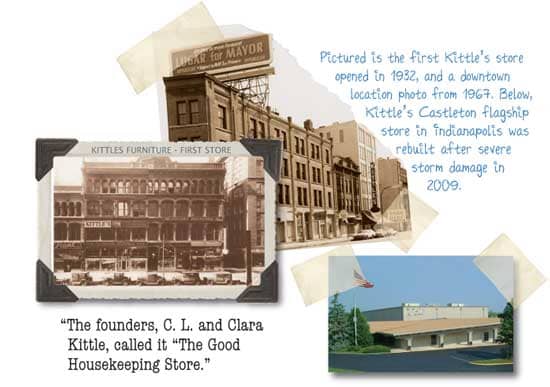
The capital of the State of Indiana, on the banks of the White River, the city has also been dubbed “The Racing Capital of the World”, famous for hosting the Indianapolis 500 and the Allstate 400 every year. The tradition was already in existence when the Kittle’s founded their small furniture and appliance store. The first 500 was staged on Memorial Day at the Speedway, May 30, 1911. The nation’s 13th largest city, Indianapolis is also home to nine institutions of higher learning, many cultural and other attractions and a vibrant night life.
In the intervening years, Kittle’s has grown exponentially and has become one of the leading home furnishings companies in the Midwest with 13 stores in their home state, and the state of Ohio.
In 1967, the third generation, Jim Kittle Junior and his brother John L. Kittle, joined the business. Jim continues to serve as Chairman of the Board today.
It was as recently as July 2009 that Kittle’s Castleton flagship store in Indianapolis sustained severe storm damage. Again undaunted, management took the opportunity while closed for repairs to re-merchandise and reposition their entire general furniture division. Since reopening, written sales have maintained an increase of more than 40 per cent with the new, broader merchandise line-up, aggressive marketing and a new position statement, “Kittle’s – For Everyone, For Less”.
Kittle’s website is not only user-friendly but fun to visit. Updated daily, there are many opportunities to view product lines, interesting facts on furniture care and a really high tech room planner to facilitate interaction between customers and design staff.
We asked what one issue, cause or policy has ensured the success of Kittle’s over the years. “Through good economic times and bad,” they told us, “Kittle’s has never wavered in its commitment to the highest standards of quality, service and value.
“Regardless how times change, customers’ expectations of you do not! Effective adaptation is only accomplished without sacrificing the key elements that your business was founded upon, and have driven your growth and success.”
Coulter’s
Coulters, Ontario’s largest furniture store, occupies an entire city block with over 80,000 square feet of showroom space and a warehouse of equal size, and they just keep getting bigger. Although the family didn’t spring into action in the broad spectrum of home furnishings until the ‘50s, they had been a name to reckon with since the mid 1800s when Alexander Coulter, a schoolteacher, immigrated to Canada from Ireland. His intelligence and a strong work ethic were Alexander’s legacy to his son, James.
James cleared his land in Colchester North in southwestern Ontario and became a lumber dealer before moving to the town of Essex in 1900 where he added coal to his inventory. In turn, his son, Charles, relocated the operation, this time to Windsor. In 1920, Windsor was a busy border city as it is today, right across the river from Detroit.
When his sons, Charles Junior (of course, Chuck!) and his brother, Bill, joined their father in the business, they were high school students, too young for action in World War II. In the ‘50s, the demand for coal dropped, and the Coulter fleet of tanker trucks served the area with fuel oil.

Their offices were located on Windsor Avenue, just east of the city’s main thoroughfare, Ouellette Avenue. By 1955, entrepreneurial sparks ignited the family’s perception to new potential and they began to offer custom fireplaces and equipment, andirons and screens.
The public seemed receptive, so three years later they opened a small room next to their offices where they offered colonial style home furnishings, very trendy at that point in time. More sparks flew when they saw furniture sales overtake profits from coal and fuel oil! In 1969, with “natural gas coming on strong”, the family sold the business and trucks to Texaco but, very wisely, kept the well positioned Windsor Avenue location.
They reinforced their new direction by broadening style horizons into traditional and contemporary home furnishings. It was then they rapidly became convinced there was “a pent up demand for quality furniture”. They initiated expansion. There was a million dollar addition in the late ‘70s and another 15,000 square feet in 1984. “We’ve probably gone this route a dozen times, and invested several million dollars over the last decade or so.”
Even in hard times, Coulters enjoys a healthy cross-border relationship with customers in the state of Michigan. They are great believers in marketing, “Getting our name visible”. They advertise both in Canada and the States, and place special emphasis on billboards, placed strategically close to the Windsor-Detroit tunnel and the Ambassador Bridge, “in the right positions to catch the eye of potential customers”.
Their marketing expertise extends to events, wine and cheese happenings, a “ladies day”, very popular, and many other avenues that tickle consumers’ fancies.
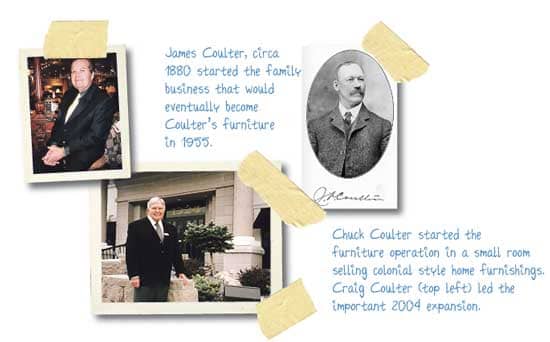
Craig Coulter, Alexander’s great great grandson, said, “The expansion in 2004 was key to our continued success. We brought in dozens of the best names in manufacturing, most of whom were North American, and that enabled us to negotiate the best prices to pass on to our customers. Some of these companies are Décor-Rest, Leathercraft, Brentwood, Canadel, just to name a few. The high quality product lines of these manufacturers, along with good pricing, allows our customers to feel confident in their investments. And that paves the way to repeat business and a solid reputation to attract new customers.
“Shortly after the 2004 expansion, to survive the slowing economy, it was necessary to cut operating costs, creating a tighter, leaner operation. We maintained profit margins by providing quality and selection at good prices, and without resorting to discounting.
“We have a top notch staff, seasoned professionals, and they played a key role with impeccable service and helpful decorating advice. Many referrals came from satisfied customers, and even long term friendships developed, building a strong foundation for the future.”
What sets Coulter’s apart? In Craig’s opinion, it’s the company’s longevity, 60 years, and their strong reputation as leaders in the industry. “We’re known for our huge showroom, vast selection, good prices and reliable service. We stand behind our product 100 per cent. And we offer six and 12 month financing, crucial to this community, especially in this challenging economy.”
The Vikings, the Chinese, Christopher Columbus, the Conquistadors, the English and the French had already made acquaintance with the people, the riches, the hardships and the potential of the Americas when Francis Bacon (1561-1626) asserted that “Histories make men wise.” Five hundred years or more before this, Marcus Tullius Cicero opined that history, “illuminates reality, vitalizes memory and provides guidance in daily life.”
Each one of our storytellers, from Millspaugh House featured in the first part of this series, to Coulter’s have risen to the occasion, and there are many more tales of hard work, entrepreneurial vision and good common sense to tell. “Histories make men wise.” And women, too!